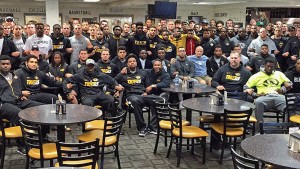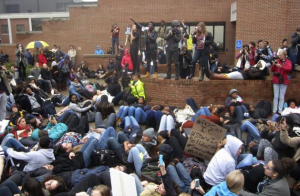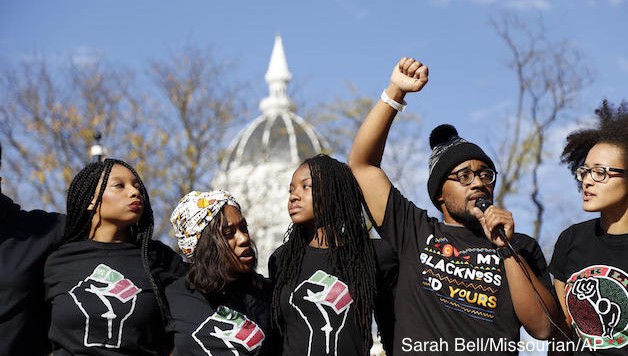“…Missouri [is] the most racist state in the country.” – John Gaskin III, a spokesman for the St. Louis County NAACP, (Bloomberg Business Week; 8/25/2014)
On November 7, black members of the Missouri (Mizzou) Tigers football team, supported by their white teammates and coaches, announced that they would not participate in football related activities as long as the university president remained in office. The immediate resignation of University of Missouri President Tim Wolfe and the chancellor of the Columbia campus, R. Bowen Loftin, sent shockwaves around the country. They serve as a warning to all university, college, and education officials that racial, sexual, and economic injustice on our campuses and in our schools will not be tolerated. We are in the midst of the emergence of a new powerful student movement in the United States.
Far from an isolated incident, Mizzou football players took their action in the context of increased activism at Mizzou, in the state of Missouri, and on college campuses nation-wide. Missouri was rocked by the events in Ferguson following the death of Michael Brown. In the fall of 2015, graduate students responded to having their health care cut, by demonstrating and eventually starting a union drive. At the same time, Chancellor Loftin provoked outrage by revoking Planned Parenthood’s admitting privileges at the University of Missouri Hospital, dealing a blow to abortion access in the whole state. (See this excellent timeline of Mizzou activism this fall). In addition, this is the football program from which Michael Sam made history as the first openly gay man drafted by an NFL team. This is a team deeply affected and concerned with their community and campus.
One Year after Mike Brown
It has been one year since the death of Michael Brown at the hands of law enforcement officer Darren Wilson. Mike Brown’s death ushered in a new phase in the long black freedom movement as the youth of Ferguson rebelled against militarized law enforcement and a corrupt city and state administration in Missouri. The banner of Black Lives Matter was raised as a life affirming act of defiance against structural racism, poverty, and oppression under capitalism.
The Ferguson uprising inspired the creation of the Mizzou student group “Concerned Students 1950” referencing the first year black students were admitted to the university. Several extreme incidents of racism coupled with the everyday harassment that black students face at Mizzou, where they are only eight percent of the student body, pushed students to speak out as part of the Black Lives Matter movement to fight for a safe university environment. They were severely let down by the university administration.
Only 110 miles from Ferguson, the University of Missouri’s Columbia campus has a history of racial strife and blatant racism. The death of Mike Brown and daily occurrences of racism spoke to the consciousness of the black student body and they organized groups around the issue such as @MU4Mike Brown, Racism Lives Here, and Concerned Students 1950 to challenge the racist history of the University and current conditions.
The Tipping Point
There were numerous incidents on campus like the blatant use of the N-word towards black students, outright racist vandalism, and a swastika drawn in human excrement and charcoal in two separate incidents in a matter of months. The denial and negligence of a University administration to the racism on campus spoke volumes to the black student body, the wider student body, and the faculty and community.

Jonathan Butler, a graduate student decided he had enough and went on a hunger strike until President Wolfe resigned. Days later, 30 black players on the Mizzou Tigers football team, inspired by the student organizing and protest, decided to stand in solidarity and decry the injustice on campus. They were joined by their white teammates, head coach Gary Pinkel, and assistant coaches in an act of unity and brotherhood as the black players announced they would withhold their labor; no practices and/or games until President Wolfe resigned as well. Despite blacks being a numeric minority in the University, they make up 69 percent of the football players. The power was clearly on the side of the students and football players which tipped the scales in the direction of justice and forced both Wolfe and Loftin to resign.
All Labor Has Dignity
The protest and self-sacrifice of the broader student body, particularly the black students, must not be lost in this struggle at the University of Missouri as so much press and praise has been heaped upon the football players and rightly so. But the daily organizing and agitation of the student activists and organizations was critical to forcing the resignation of Wolfe and Loftin.
President Wolfe had no experience in education when he was hired to run Mizzou in 2010. Wolfe sought to turn the university into a Fortune 500 tech corporation: he slashed and burned the academic publisher associated with the university; cut graduate student health care; and cut tuition waivers for graduate students who taught courses. In addition, the “image” of the university was held paramount: instead of addressing systematic racism on campus, the administration instead treated each incident as a matter to investigate separately. A premium was placed on income-generating parts of the university – particularly the football program. These attacks are part of a trend that is no less than a national plan to slowly privatize and erode public education and services for students, campus workers, and the community with the goal of maximizing the profits and profile of the universities and corporations.
This protest by Mizzou players builds on the powerful example of the Northwestern football team’s efforts to unionize over a year ago and represents further progress in collegiate athletes being seen as workers/employees. The announced labor strike by the Mizzou football team, and, significantly, its black players, would have cost the university $1 million in forfeiture fees per game. The biggest blow would be to Mizzou’s reputation, and the donor confidence in the leadership. We must remember that this team was in the hunt for a NCAA national championship just two years ago.
The act of solidarity and strike threat exhibited the potential power of the athlete in contemporary capitalism that has turned sports into a corporate-controlled mass consumption commodity and mindless entertainment. The Mizzou players realized their strength and the threat of withholding their labor forced the hand of the board of trustees and President.
“We Are United”

The protests in Mizzou, Yale, Berkeley High School, and Ithaca against racism, environmental destruction, corporate dominance over education, tuition hikes, and student debt are all part of a revitalization of the student movement.
The anti-immigrant, racist and misogynist rhetoric of Donald Trump, Ben Carson and others in the GOP is encouraging the expression of reactionary views by a minority in our society and this is having a reflection on campuses. As if to stress this point, Trump and Carson have called the demonstrations “disgusting” and “infantile.” The Democratic Party establishment, on the other hand, expresses sympathy with the demonstrators’ aims; but from “ending welfare as we know it” to the policies that created mass incarceration, it is fully implicated in the structural racism that creates the breeding ground for the type of attacks we have witnessed at Mizzou.
There have been threats against the activists and movement at Mizzou following the resignation and backlash from the corporate media on how reporters were handled during the protest on campus. We must defend the right to organize and protest without reprisals from racist vigilante forces or even by the state, while at the same time being watchful of the corporate media and their reporting of events which is meant to cast a dark cloud over the activists and movements as they did following Mike Brown’s death. The movement must come up with a plan to deal with genuine reporting of events instead of alienating potential press that could help expand and spread the message of fighting back against racism at Mizzou.
What Mizzou has taught us is that the old labor movement mantra of “An injury to one is an injury to all” is relevant and powerful as a counterweight to racism, xenophobia and capitalist oppression. Student activism is a powerful tool, but the strike of football players showed that students must focus on demands, strategy, and tactics that reaches out to, and involves the university staff and employees. They are the ones who truly have the power to stop the running of the institution.
Black Lives Matter has bolstered student activism nationally; last week there were solidarity demonstrations with Mizzou on campuses around the country, some of them linking up the Million Student March for free education and to cancel student debt. On campuses, students should join these movements and use this inspiration to build further fights against cuts to education. Activists should work to create lasting coalitions that fight on issues from racism on campus to fighting for a campus-wide $15 minimum wage. Socialist Alternative is involved with the Million Student March and various students for Bernie clubs.
Working people can take inspiration from the heroic activism of the students at Mizzou and the brave stand taken by the football team. Only a united and cohesive working class mass movement rooted in our commonalities and not our artificial “differences” can challenge and uproot the edifice of oppression at home and abroad.


